Search the Special Collections and Archives Portal
Search Results

Architectural drawing of the Holiday Inn and Casino (Las Vegas), master plan, west to east section (Las Vegas), November 1, 1987
Date
Archival Collection
Description
Proposed master plan cross section of the Holiday Inn and Holiday Casino in Las Vegas. Original medium: pencil and ink on tracing paper. The property became Harrah's Las Vegas in 1992.
Site Name: Holiday Casino
Address: 3475 Las Vegas Boulevard South
Image
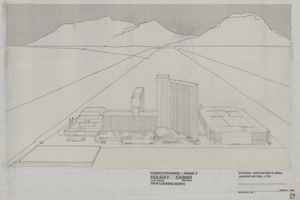
Architectural drawing of the Holiday Inn and Casino (Las Vegas), master plan, view looking north, March 4, 1988
Date
Archival Collection
Description
Bird's eye rendering of proposed Holiday Inn and Casino expansion in Las Vegas. Includes revision date. Original medium: pencil on tracing paper taped to mylar. The property became Harrah's Las Vegas in 1992.
Site Name: Holiday Casino
Address: 3475 Las Vegas Boulevard South
Image
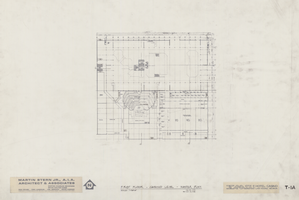
Architectural drawing of Xanadu Hotel and Casino (Las Vegas), casino level master plan, December 31, 1975
Date
Archival Collection
Description
First floor (casino level) master plan for the Xanadu Hotel and Casino. Revised in Jaunuary, 1976. Printed on mylar. The Xanadu was to be located where the Excalibur Hotel and Casino currently sits, but it was never built. Berton Charles Severson, architect; Brian Walter Webb, architect.
Site Name: Xanadu Hotel and Casino
Address: 3850 Las Vegas Boulevard South, Las Vegas, NV
Image
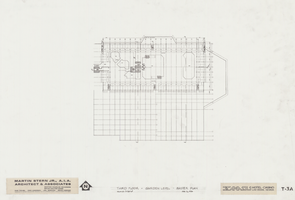
Architectural drawing of Xanadu Hotel and Casino (Las Vegas), garden level master plan, February 17, 1976
Date
Archival Collection
Description
Third floor (garden level) master plan for the Xanadu Hotel and Casino. Printed on mylar. The Xanadu was to be located where the Excalibur Hotel and Casino currently sits, but it was never built. Berton Charles Severson, architect; Brian Walter Webb, architect.
Site Name: Xanadu Hotel and Casino
Address: 3850 Las Vegas Boulevard South, Las Vegas, NV
Image
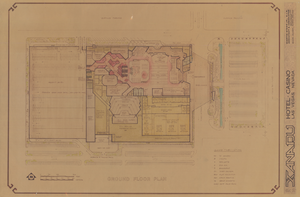
Architectural drawing, Xanadu Hotel and Casino (Las Vegas), sketches, ground floor plan, circa mid 1970s
Date
Archival Collection
Description
Color sketch of the proposed Xanadu Hotel and Casino ground floor plan. Includes game tabulation. Parchment. The Xanadu was to be located where the Excalibur Hotel and Casino currently sits, but it was never built. Berton Charles Severson, architect; Brian Walter Webb, architect.
Site Name: Xanadu Hotel and Casino
Address: 3850 Las Vegas Boulevard South, Las Vegas, NV
Image
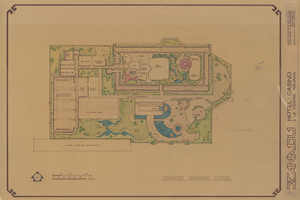
Architectural drawing, Xanadu Hotel and Casino (Las Vegas), sketches, garden level, circa mid 1970s
Date
Archival Collection
Description
Color sketch of the proposed Xanadu Hotel and Casino garden level floor plan. Parchment. The Xanadu was to be located where the Excalibur Hotel and Casino currently sits, but it was never built. Berton Charles Severson, architect; Brian Walter Webb, architect.
Site Name: Xanadu Hotel and Casino
Address: 3850 Las Vegas Boulevard South, Las Vegas, NV
Image
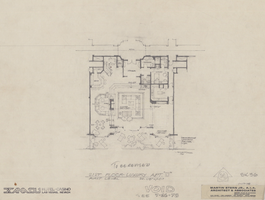
Architectural drawing, Xanadu Hotel and Casino (Las Vegas), sketches, luxury suite D, January 17, 1978
Date
Archival Collection
Description
Sketch of the proposed Xanadu Hotel and Casino luxury suite D on the 21st floor. Includes handwritten text: "to be revised" and revision dates. Original medium: pencil on tracing paper. The Xanadu was to be located where the Excalibur Hotel and Casino currently sits, but it was never built. Berton Charles Severson, architect; Brian Walter Webb, architect.
Site Name: Xanadu Hotel and Casino
Address: 3850 Las Vegas Boulevard South, Las Vegas, NV
Image
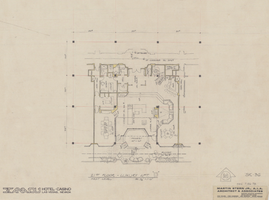
Architectural drawing, Xanadu Hotel and Casino (Las Vegas), sketches, luxury apartment D, first level, July 26, 1978
Date
Archival Collection
Description
Sketch of the first level of the proposed Xanadu Hotel and Casino luxury apartment D on the 21st floor. Original medium: pencil on tracing paper. The Xanadu was to be located where the Excalibur Hotel and Casino currently sits, but it was never built. Berton Charles Severson, architect; Brian Walter Webb, architect.
Site Name: Xanadu Hotel and Casino
Address: 3850 Las Vegas Boulevard South, Las Vegas, NV
Image
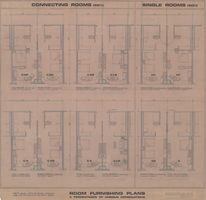
Architectural drawing, Xanadu Hotel and Casino (Las Vegas), sketches, room furnishing plans, circa 1978
Date
Archival Collection
Description
Room furnishing plans and percentages of various combinations for the proposed Xanadu Hotel and Casino. Parchment ozalid. The Xanadu was to be located where the Excalibur Hotel and Casino currently sits, but it was never built. Berton Charles Severson, architect; Brian Walter Webb, architect.
Site Name: Xanadu Hotel and Casino
Address: 3850 Las Vegas Boulevard South, Las Vegas, NV
Image
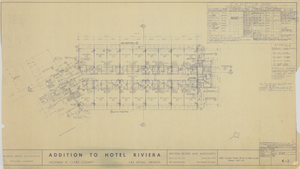
Architectural drawing of Riviera Hotel and Casino (Las Vegas), third through eighth floor plan, January 31, 1959
Date
Archival Collection
Description
Tower levels three through eight floor plans for a 1959 addition to the Riviera Hotel and Casino. Drawn by J.M. Includes revision dates and interior finish schedule. Facsimile. Murray Erick Associates, structural engineers.
Site Name: Riviera Hotel and Casino
Address: 2901 Las Vegas Boulevard South
Image
